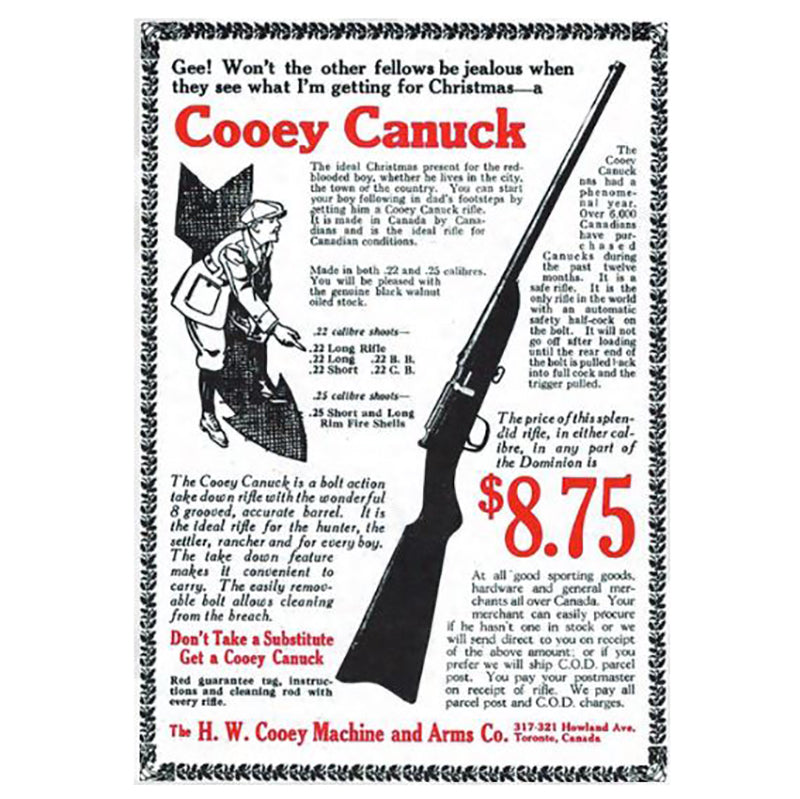Free Shipping on Canadian orders over $175
Free Shipping on Canadian orders over $175

The Canadian Boy's Gun
January 21, 2020 4 min read 6 Comments
by Wayne Goble
I can safely say the H.W. Cooey Machine arms co. has contributed to more happy Christmas mornings, more early morning forays in the woods for small game and more fun plinking cans and paper than any other firearms manufacturer in Canada by far.
I’ve talked about Cooey firearms before but I’m not sure whether I have really driven home how much the Cooey firearm, especially the 22 rifle, dominated the Canadian Firearms landscape. Many shooters now find room in our budget for a new Browning T Bolt or a Ruger 10/22 or something in a CZ 457 series or Anschutz Target Rifle, but my question is this: will you ever find the excitement or early murmurs of adulthood that came with your first outing with Dad, Grandad or your big brother and a Cooey? Though he unfortunately passed away a year or so after, I remember like it was yesterday when my grandfather let me shoot his Cooey Mod 60 repeater out in the backyard by our general store. I was about 8 and Grandad directed the muzzle and set the gun so I could see down the sights. I had shot a BB gun quite often before, but the crack of the bullet and the pungent smell of the powder in Whizbang Smokeless 22s is one of my most vibrant, and happiest, childhood memories.
HW. Cooey Machines and Arms Co. was founded in 1919 and their first firearm was the “Cooey Canuck” which was well received by the Canadian public but was not even a blip internationally. Over the next decade Cooey produced the Ace 1, Ace 2 and Ace 3 with variations; a line of single shot 22’s that began to expand their customer base. The factory was moved to Cobourg Ontario from Toronto. Even when the Great Depression struck, Cooey Co. survived, built on their past success and ability to produce a relatively inexpensive firearm perfect for tough times. Many of the early Cooey Single shots and repeaters did not have model numbers on the receiver but were simply listed as “Cooey 22 cal. Cooey Special.” The first 22 repeater, which appeared in 1934, was just called “Cooey Repeater.” Over the years Cooey produced house brands “Eatonia” for Eaton’s; the largest department store in Canada, “Sure Shot” for Simpsons department stores and “Hiawatha” for McLeod’s western stores.
In approximately 1932 H.W. Cooey began assembling and finishing shotguns for Iver Johnson Arms and Cycle Works. The American and International ammunition and firearms companies like Remington, Winchester, Ithaca etc. established assembly and loading facilities in Canada to avoid paying duties and tariffs when crossing the border; there was no North American Trade Treaty. That was likely the impetus of the Iver Johnson and Cooey joint venture as well. A single barrel shotgun called the “Champion” and a double barrel shotgun called the “Hercules” were assembled and finished with “Cobourg” stamped on them, but the shotguns bore the name of Iver Johnson with a Montreal Canada address. Even today the Iver Johnson Champion is quite common in Canada and I’ve run across multiple Iver Johnson Hercules in older collections and estate purchases.
It was around 1935 Cooey began giving their rifles a model number. The 22 LR Single shot became the 39 and the 75. The 22 repeater became a Model 60. Cooey also introduced a Model 35 which was a pump action repeater and was manufactured from 1935-1939. It was not the best designed and quite often had some functionality problems but today, because of its relative rarity, is prized by collectors.

Cooey entered the shotgun business wholeheartedly in 1948. The model 84 single shot exposed hammer shotgun was produced in 12,16, 20, 28ga and 410 and was produced in different variants. Their longtime business partners Eaton’s and McLeod’s also received their own version of the popular design. The same design would also be produced later as a Winchester in the 1970s.

The H.W. Cooey Machine and Arms Company was purchased by Olin-Mathiesan Ltd. in 1961 and became a division of Winchester-Western. The Cooey line became part of the Canadian Winchester Catalogue in the 1960’s and 70’s.
In 1964 Winchester Cooey entered the semi auto 22 LR market with the Cooey Model 64 semi auto rifle. It was offered in standard and deluxe versions. One of the main changes over the years for the model 64 was going from a plastic clip to a metal clip which gave it more longevity. Savage Arms came into possession of this extremely popular design when they purchased the Lakefield Arms company and its Lakefield Ontario factory, which was where many of the Cooey employees, machinery and patents landed after Cooey was shuttered. And today you can still buy the largely unchanged Cooey as the Savage Model 64.
In 1979 Winchester closed the Cobourg factory and ended the line of Cooey Firearms.
The historic models and variations produced over the 60 years of Cooey and Cooey Winchester’s existence is enough for a good size book and I intend to revisit some of the variants and design changes here in a later post. Despite their age and wide availability, Cooeys seem to still grow in popularity with both shooters and collectors and, as a result, these inexpensive guns are enjoying a renaissance in their value and popularity. But that doesn’t mean they’re not still a great choice for an affordable starter gun and possibly one of the best choices for making a new memory with an enthusiastic little shooter that might also look back fondly on the first time they felt grown-up, shooting with Grandad.
6 Responses
Archie Anderson
August 11, 2023
My father handed down to me in 1975 his Cooey Model 84 in 16 ga He purchased it when he was 17 years old for $18.00 from the T Eaton Co. I still have that gun today. My father shot hundreds of ducks with it over the years, But He witnessed me shoot the first 2 geese ever to be shot with his old faithful 84. I also have his very 1st 22 bolt Etonia he purchased at age 16 from the T Eaton Co in Toronto. He paid $7.00 and i had the pleasure of shooting my very first groundhog with this gun in 1965 at age 6. I love these guns and shoot them on a regular basis.
Les Hoyle
August 11, 2023
Does any one know any information on a Canuck 25 Calibre I know it’s fairly old
I have tried to find ammunition For it but know luck
Fred Wright
June 03, 2021
I was lucky enough to obtain an old Cooey Single Shot that has no serial # or Model.
It was said to be owned by Herbert Cooey. The only thing on the barrel is ‘Senior’.
It still fires fine and may date back to the very beginning. It certainly looks just like the one in the old advertisement.
I acquired it while working for Cooey Metal in Brighton Ontario in the early 80’s.
Horst Schneider
June 03, 2021
My first boyhood .22 was a single shot Remington. Same great memories of shooting with my father.
I recently acquired a Model 64 Cooey with the plastic magazine. A good and reliable shooter
thanks for the article.
Wayne Elliott
July 30, 2020
Thanks for a great read did not know when the pump action was made. Love how accurate and dependable cooeys are.
Leave a comment
Comments will be approved before showing up.
We clean up after ourselves.
Ecommerce deliveries have a carbon footprint. That's why we support verified projects that remove carbon from the air.



Every delivery’s carbon footprint is calculated based on weight, shipping method, and distance traveled. We neutralize these emissions by purchasing verified carbon removal credits from groundbreaking projects.



With your purchase, you’ll join a community of proactive merchants and customers dedicated to a sustainable future. Together, we've removed emissions for over 71 million deliveries and removed over 50 thousand tonnes of carbon.

We work with a network of pioneering carbon removal companies that have been vetted by the commerce platform Shopify.


Paul Ankcorn
August 11, 2023
I have a pre-1935 Cooey Model 39 single shot. No serial numbers and no model name are on the barrel. I got it from my father, he from his father. I learned to shoot it while a boy on the farm in Northumberland County (Warkworth) ON. Prior to taking ownership of it, the rifle was not particularly well taken care of. I know with certainty that my father never had a cleaning kit and did not store it well (it was stored in a cloth case never locked) Once I took ownership of it, I took good care to clean it up and maintain it well. It still shoots reliably and is quite accurate (shoots slightly high and to the right at 100 yds). I am a range safety instructor and use this rifle to train new shooters and youth before progressing them to repeaters. Love Cooey’s. A piece of Canadian history and part of our heritage as a nation.